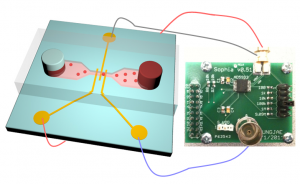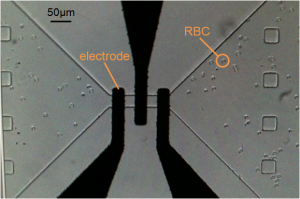Malaria-diagnostic System Based on Electric Impedance Spectroscopy
- Category: Circuits & Systems, Medical Electronics, MEMS & BioMEMS
- Tags: Anantha Chandrakasan, CICS, Sungjae Ha
Malaria prevails mainly in the countries that lack proper medical facilities, and it kills about a million people worldwide a year. This parasitic disease invades human red blood cells (RBCs), and it is life-threatening unless treated immediately [1] .
This work focuses on utilizing a single cell analysis technique to develop a rapid malaria diagnostic test system among various approaches to diagnose the disease in its early stage. Single cell analysis based on electronics enables high throughput tests of biological cells. The specific analysis method used in this research is electric impedance spectroscopy (EIS), which measures the electric impedance of biological cells flowing continuously over a pair of electrodes, so that it can differentiatecells whose impedance is highly correlated to cell size and cytoplasm permittivity [2] [3] [4] [5] [6] .
The system consists of two parts: a MEMS probe and a reader circuit. To investigate one cell at a time and to achieve enough sensitivity to tiny (<10 µm) human red blood cells, a MEMS device consisting of a microfluidic channel and micro-electrodes is fabricated. The probe MEMS device is made of transparent materials except the electrodes for convenience of monitoring. In addition, a printed-circuit-board using a commercial impedance-to-digital chip is made to continuously measure electric impedance in high-speed manner. The circuit board generates a sinusoidal voltage signal, measures the DFT of the resulting current, and calculates the impedance from DFT. We are seeing this system as a possible solution for developing a low-power, highly sensitive, and cost-effective malaria diagnostic device.
- Figure 1: Schematics of the device and the experiment setup. From one punch through the PDMS cell, whole or diluted blood is injected, and it comes out the outlet on the other side. Electric impedance is measured by the attached circuit board.
- Figure 2: PMDS channel size of 160 µm x 30 µm x 5 µm (center). Ti-Au electrodes are placed beneath the channel to apply a voltage and measure the resulting current (dark parts). Small disk-shaped particles are human red blood cells.
- World Health Organization Staff, World Malaria Report 2009, World Health Organization, Geneva, Switzerland, 2009. [↩]
- A. Valero, T. Braschler and P. Renaud, “A unified approach to dielectric single cell analysis: Impedance and dielectrophoretic force spectroscopy,” Lab on a Chip, vol. 10, pp. 2216-2225, June 2010. [↩]
- H. Morgan, T. Sun, D. Holmes, S. Gawad and N. G. Green, “Single cell dielectric spectroscopy,” J. Phys. D: Appl. Phys., vol. 40, pp.61-70, 2007. [↩]
- H. E. Ayliffe, A. B. Frazier and R. D. Rabbitt, “Electric impedance spectroscopy using microchannels with integrated metal electrodes,” J. Microelectromechanical systems, vol. 8, Mar. 1999. [↩]
- C. Ribaut, K. Reybier, O. Reynes, J. Launay, A. Valentin, P. L. Fabre and F. Nepveu, “Electrochemical impedance spectroscopy to study physiological changes affecting the red blood cell after invasion by malaria parasites,” Biosensors and Bioelectronics, vol. 24, pp. 2721-2725, Dec. 2009. [↩]
- L. I. Segerink, A. J. Sprenkels, P. M. ter Braak, I. Vermes and A. van Den Berg, “On-chip determination of spermatozoa concentration using electrical impedance measurement,” Lab on a Chip, vol.10, pp. 1018-1024, Feb. 2010. [↩]

